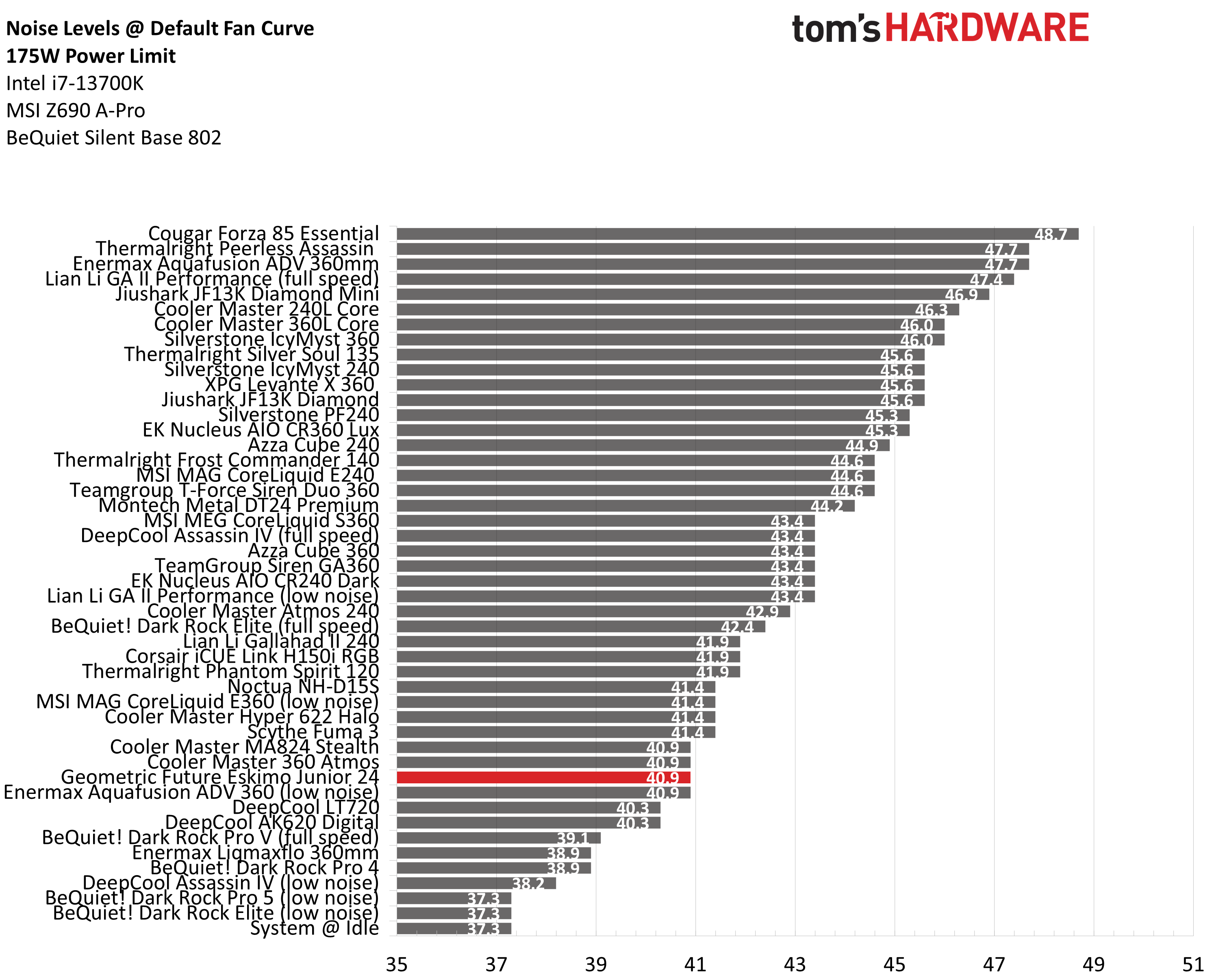Why you can trust Tom's Hardware
Thermal results without power limits
Without power limits enforced on Intel’s i7-13700K, the CPU will hit its peak temperature and thermally throttle with even the strongest of air coolers. When the CPU reaches its peak temperature, I’ve measured the CPU package power to determine the maximum wattage cooled to best compare their performance. The results below do not include the best liquid coolers on the market, which can keep the CPU under TJ Max (100C).
Geometric Future’s Eskimo Junior 24 doesn’t break any records here, with overall performance comparable to a mid-range air cooler. However, it doesn’t run loudly either. Compared to other liquid coolers on the market, the Eskimo Junior runs fairly quietly, even at full speed.
Thermal results with noise normalized to 38.2 dBA
Finding the right balance between fan noise levels and cooling performance is important. While running fans at full speed can improve cooling capacity to some extent, the benefits are limited and many users prefer a quiet system. With this noise-normalized test, I’ve set noise levels to 38.2 dba. This level of noise is a low volume level, but slightly audible to most people.
As with the previous thermal results, the Eskimo Junior doesn’t stand out from the crowd when noise levels are set to run quietly. With 214W cooled on average during testing, its performance is comparable to air coolers like DeepCool’s AK620 and BeQuiet’s Dark Rock Pro 4. This isn’t bad per se, but it is behind most current-generation 240mm AIOs, which can cool closer to 228W with the same noise levels.
175W Cinebench results
Most coolers on the market can keep Intel’s i7-13700K under its peak temperature if the power consumption is limited, so for this test, we’ll be looking at the CPU’s actual temperature.
With a steady 175W load run on the CPU, the temperature averaged 58 degrees C over the ambient room temperature of 23 C – typical of mid-range air coolers.
With the maximum noise results above, I limited results to other liquid coolers on the market to make it easy to see how it runs quieter than other AIOs. The noise levels are indeed lower than other liquid coolers, but similar to the mid-range air coolers that the Eskimo Junior offers performance comparable to. This makes it hard to recommend over those air coolers.
Get Tom's Hardware's best news and in-depth reviews, straight to your inbox.
125W Cinebench results
The lowest power limit I test with Raptor Lake CPUs is 125W. This is a high enough limit to allow the CPU to maintain its base clock speeds even in the most intensive tests, and most coolers should be capable of keeping the CPU below TJ Max (the max temperature before throttling) – even low-end coolers.
Really, thermals don’t matter much in this scenario. Even Intel’s stock cooler can handle a load like this with ease. Noise levels, rather than CPU temperature, are the most important factor here. Running at 38.2 dBA, the Eskimo Junior 24 is indeed quiet – just a hair louder than the most silent coolers I’ve tested in this scenario.
Conclusion
Geometric Design’s Eskimo Junior 24 offers a unique design and aesthetic. with some tasteful RGB that doesn’t overwhelm. This is a welcome change from certain other coolers that feel like they’d be better suited to a rave than inside a computer. However, its performance and noise levels are comparable to mid-range air coolers that are generally cheaper, and that makes it hard to recommend unless you specifically buy your cooler for its aesthetics.

Albert Thomas is a contributor for Tom’s Hardware, primarily covering CPU cooling reviews.
-
nickc120167z I installed this a month ago and I like it. Paired with a ASUS Maximus XIII Hero board and a 11th gen I-5 the RGB does not light up the whole room. Was on sale for $79.99 when I bought it.Reply







